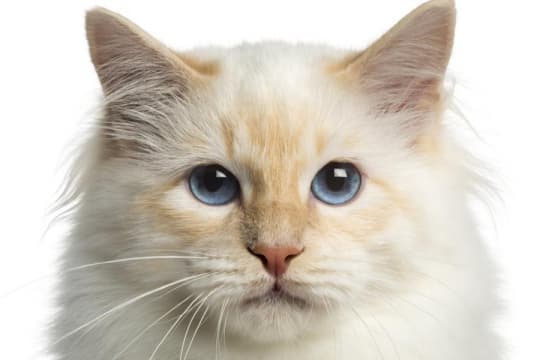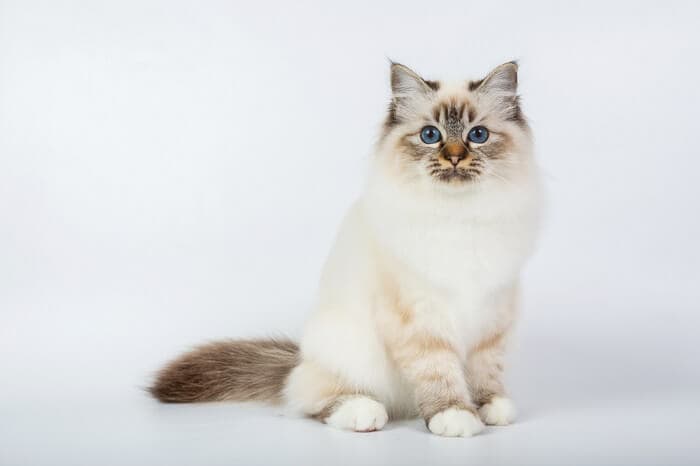
birman
Relaxed, affectionate, inquisitive, intelligent
Overview
Origin
Burma
Life Span
12-16 years
Height
8"-11"
Weight
6-14 pounds
Group
Medium sized longhair
Price
$400 - $1,000
History

Many cats come with unique stories attached, but the Birman is unique in that the breed is surrounded in mystery. As the legend goes, a Kittah priest called Mun-Ha was worshiping at the Temple of Lao-Tsun, accompanied by a white temple cat named Sinh.
Raiders entered the temple and killed Mun-Ha. As the priest lay dying, Sinh placed his feet on his body and faced the goddess Tsun-Kyan-Kse. The cat was transformed; his body turns to a golden color, his eyes turned blue, and his legs changed to brown. His feet remained white where they touched his master. Legend says that the Birman cat's white feet are a symbol of purity.
At the same time, the rest of the temple cats were transformed, taking on the same appearance as Sinh.
The temple of Lao-Tsun was actually raided again in 1919. Two men, Major Gordon Russell and Auguste Pavie, came to the aid of the priests. As a gesture of gratitude, the priests gave the men a breeding pair of Birman cats, which were transported to France. It is believed that many Birman foundation cats were Siamese.
Sadly, the end of World War II saw only one pair of Birman cats remaining alive, even though the breed had begun to gain popularity. By the 1960s though, there were enough Birman cats to allow for importation into England. The breed gained popularity, and by 1966, was officially recognized by British cat fancy associations.
The first Birman cats arrived in America in 1959 and CFA granted the breed official recognition in 1967.
Care

Nutrition
Birman cats do not have any special nutritional requirements, however they thrive on high-protein diets. We recommend feeding your Birman cat a high-quality cat food.
Grooming
Even though Birman cats have long hair, they are relatively easy to care for compared with many other long-haired cat breeds. The Birman cat's hair is fine and silky, with a single coat that is not prone to matting. Routine brushing – at least once daily – will help keep this kitty's coat in great shape and provide both of you with a pleasant bonding experience.
Exercise
Birman cats need plenty of exercise each day and you may need to help them get it. These cats love to lounge; however, they will happily play with toys when encouraged to do so. A cat tree is ideal for napping, but it's also essential for stretching and climbing.
Health
While the Birman cat has a reputation for overall good health, these kitties can be prone to obesity. Keep your cat active, and make sure that you are offering an appropriate, high-protein diet to help your cat maintain a healthy, comfortable weight.
Breed Standard

Body
The Birman is a medium-sized cat with solid musculature.
Head
The head should be well rounded, without strong angles or flatness. Features should be strong. The cheek should be full, and the four head should slope back. The nose should be of medium length and should begin just below the eyes. It should have a Roman shape. The chin should be full with a slight taper, but should not recede.
Eyes
All Birman cats have round, blue eyes. Seal point Birman cats should have deep blue eye coloring. Cats with other coat colors display a lighter, brighter shade of blue.
Ears
The ears should be of medium size, with wide bases and rounded tips. The base of the ears should be nearly as wide as the ears are tall.
Color
At maturity, Birman cats are always color pointed, with the mask, ears, legs, and tail all clearly defined. The mask should cover the entire face, including the whisker pads, and should be connected to the ears by color tracings. The remainder of the coat should display a cream to golden tint and the belly should be an off-white color. Their coats colors may be sealed, chocolate, blue, lilac, cream, red, cinnamon, frost, or tortie. Their points may be solid or show a lynx pattern.
Coat
The coat should be a single layer with a fine, soft feel. There is a slight ruff around the neck.
Tail
The tail should be wider at the base and taper to a rounded tip. A Birman cat’s tail should be fully plumed, and should be of medium length.
Legs & Paws
The legs should be strong and well-proportioned, and should appear slightly short in comparison to the body. The feet should be well rounded. All Birman cats have white paws. The white may cover the toes only, or may extend as far up as the joint between the foot and the leg. Ideally, all four feet should have the same amount of white; however, judges do make exceptions, particularly when a cat's back paws display more white than front paws.